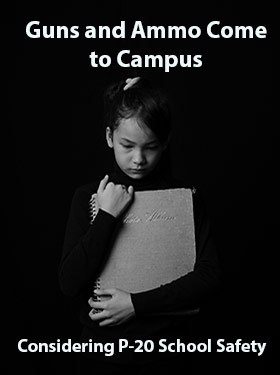Jonesboro . . . I remember where I was. It was 20 years ago, as a doctoral student at the University of Illinois at Urbana-Champaign, that I first heard the name Jonesboro. While my father’s family hails from Arkansas, I can say I was not familiar with Jonesboro, Arkansas before 1998. It was unfathomable at that time to process the evening news of an 11-year-old and a 13-year-old pulling a fire alarm to draw students and teachers out of their middle school and ambushing them with gunfire from a nearby wooded area, killing four female students and one teacher and wounding 10 others at Westside Middle School. On the heels of Jonesboro came the Columbine High School massacre in Colorado, and the presumption of safety at school has never been the same. Over the past two decades, news outlets have been saturated with portrayals of what was thought of as a few isolated incidents in the late 1990s, and has evolved into a national trend with over 187,000 K-12 students having experienced a shooting during school hours (Cox & Rich, 2018).
School Safety: A Pipeline Problem and Persistent Concern
Valentine’s Day is associated with love, cupid, candies, and sweet sentiments. However, on February 14, 2018, Valentine’s Day was marked with the deaths of 17 students of Marjory Stoneman Douglas High School (MSDHS) in Parkland, Florida, killed by a gunman that was a discharged student from MSDHS. In the short time since this heartbreak, though plagued by grief, MSDHS students felt prompted to act to prevent senseless loss of lives to gun violence, organizing the March for Our Lives. On March 24, 2018, youth from across the country and adult allies of these impassioned teens descended on the nation’s capital in organized protest and activism, calling out Congress to enact stricter gun control laws. March 24th marks not just a day of youth uprising, agency, and voice to rally against gun violence and call for school safety, but it is also the anniversary of the Jonesboro school shooting 20 years ago. The Jonesboro assailants had three semi-automatic rifles, 200 rounds of ammunition, and a stockpile of supplies in a stolen van. The Jonesboro shooters are the only living U.S. mass school shooters not incarcerated, due to being ages 11 and 13 at the time of the offense. Adding more insult to injury, roughly 10 years ago, each of the former juvenile shooters applied for conceal carry permits upon release from juvenile detention.
Recently the National Institute of Justice (NIJ) pulled the Comprehensive School Safety Initiative and the Research and Evaluation of Technologies to Improve School Safety solicitations to reallocate monies for other purposes under the Stop School Violence Act of 2018. The Stop School Violence Act of 2018 essentially picks low-hanging fruit; it is not far-reaching in gun reform policies to ensure greater protections in elementary, secondary, and postsecondary settings. Elementary schools (e.g., Sandy Hook) have been struck by gun-violence fatalities just as middle and high schools have been affected. Higher education institutions more so than PK-12 educational settings are penetrable open access spaces that are target rich and vulnerable to attack.
Campus Safety and the Community College Context
While 4-year universities have been the site of catastrophic gun violence (e.g., the Virginia Tech shootings that claimed the lives of 32 students and teachers), community colleges, unlike their 4-year counterparts have more dispersed student bodies, fewer residential facilities, and fewer resources to reduce risk and crises (Hephner LaBanc & Hemphill, 2015). Community colleges have emerged in the headlines in recent years with active shooters and active shooter threats on campuses (e.g., Harford Community College in Maryland, Wayne Community College in North Carolina, Lansing Community College and Mott Community College in Michigan). In May 2017, Irving Community College in Dallas, Texas, experienced a shooting on campus leaving one dead, after which the shooter committed suicide. By August 2017, licensed gun owners were granted permission to carry concealed firearms at public Texas community colleges. Several states in addition to Texas introduced campus carry bills in 2017. Debates are ongoing as to whether carry and concealed gun permissions improve campus safety, are more harmful to public safety, and/or curb mass shootings. Not debatable is the increased safety risks on campuses such as the Umpqua Community College shootings on October 1, 2015 leaving 10 dead and seven injured.
Reality Check and Safety Steps
I would love to escape to the utopia where campuses do not have to enforce risk reduction and prevention activities, where students and instructors do not have to be mindful of where to hide, whether to play dead, or have a loaded gun pointed in their direction. Nevertheless, the continued disquiet of students having to traverse an educational system riddled with the ricochet of bullets is a sad reality—gun violence is an American norm. Administrative leaders must stay vigilant in preparing students, faculty, and staff with active shooter drills, survival training for incidents of violence that can strike at anytime and anywhere. Even though every campus is different, no institution is unique when it comes to safety being paramount. What is universal across institutional types and tiers is the necessity of doing regular threat assessments, updating emergency preparedness plans, and having a critical incidents response group. These are just a few measures for navigating what was once inconceivable. #ENOUGH
